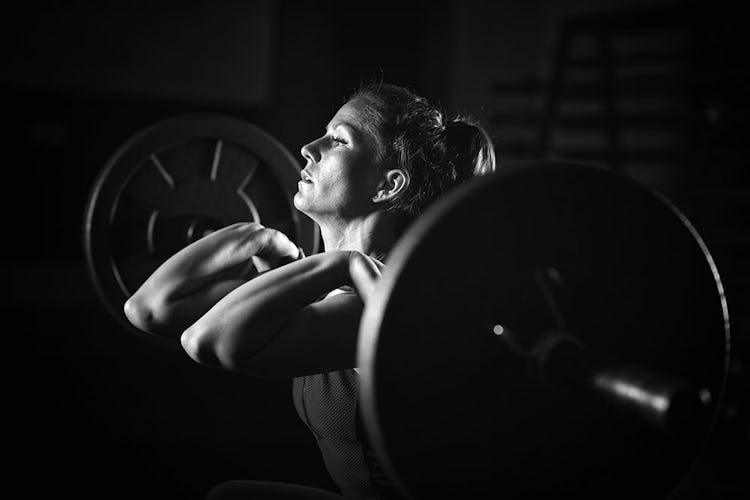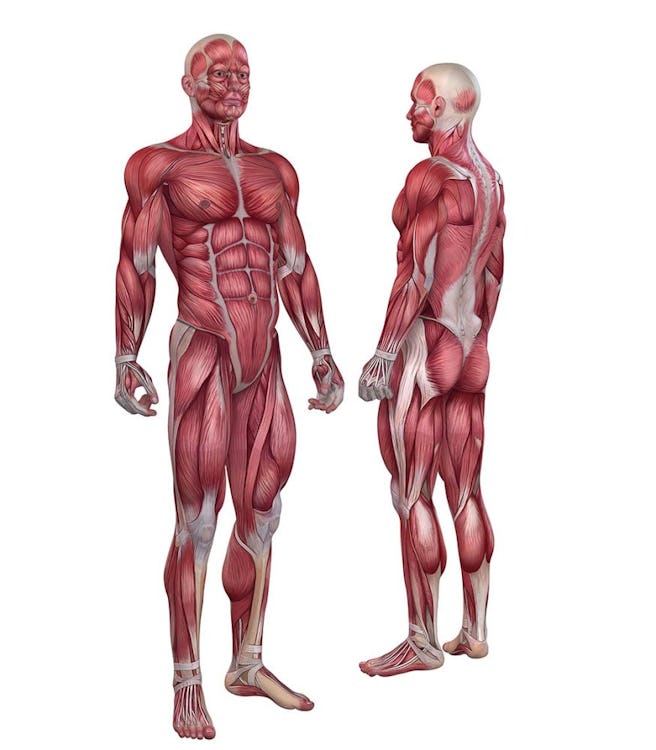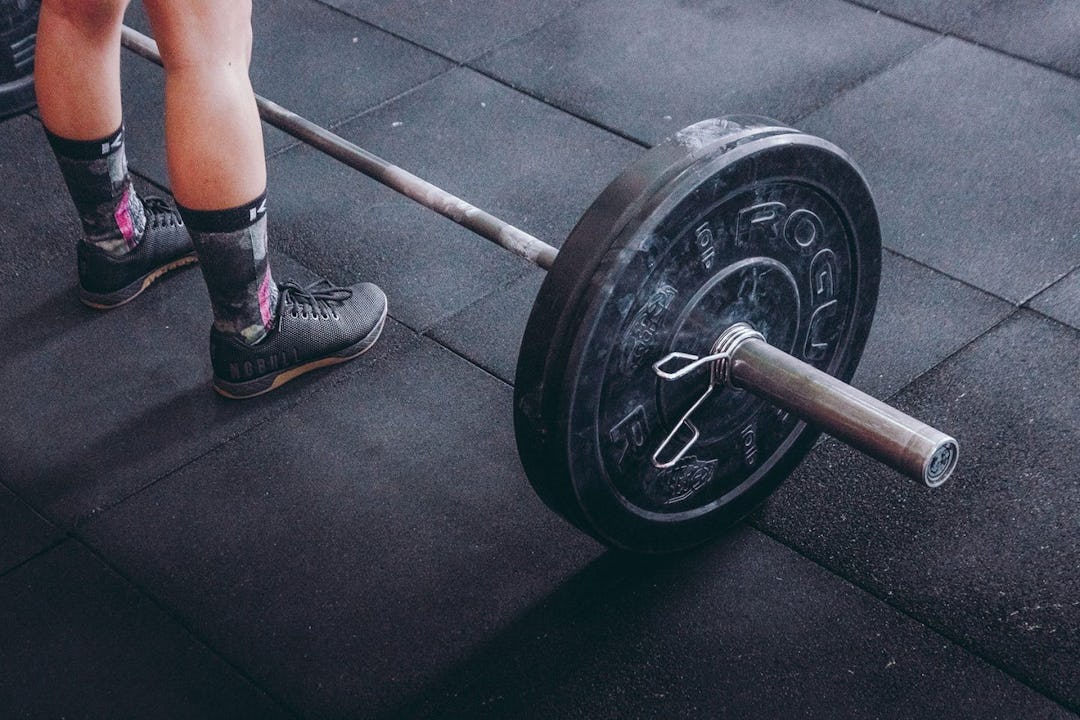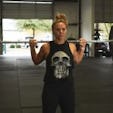It’s the great irony of fitness: we keep innovating, but, at the same time, we’re always going back to basics.
Despite new apps, new equipment, new gyms, and new online training platforms, the biggest, strongest, leanest, and most powerful people on the planet still skip most of the trends (fads?) and do the same basic lifts that their predecessors relied on a century ago. For example, squats and cleans with a good old-fashioned barbell.
Combine these two classic movements and you have the squat clean, a foundational exercise for Olympic weightlifters, and a great choice for people who are looking to get stronger, more explosive, and more functionally fit overall.
In this guide, you’ll learn why the squat clean is timeless, and how to implement it properly in your training to maximize benefits and minimize injury risk.
What Is the Squat Clean?

The squat clean is another name for the first half of the clean and jerk movement—a lift that’s performed in Olympic weightlifting contests. In the clean and jerk, the clean has you pull the weight off the floor and heave it up to your shoulders (called the rack position), and, in the same motion, lower into a full front squat and then stand back up. The jerk is when you then dip your knees and power the bar up overhead to lockout. To perfect the movement, weightlifters often train the components of the clean and jerk separately, hence the squat clean exercise (cleaning the weight and squatting it).
Most people who have played football or done CrossFit are familiar with power cleans, a variation in which you catch the bar on your shoulders and dip your knees slightly to absorb the force. In other words, the power clean omits the squat. Another difference is that, in a classic full-range, weightlifting clean/squat clean, you pull your body underneath the bar as it approaches your shoulders. This reduces the clean’s range of motion slightly, and allows you to use more weight. The squat clean, then, is a more challenging progression of the power clean, and it better simulates the requirements of a full clean and jerk.
“The squat clean sounds simple, but when executed properly, it’s actually an incredibly complex exercise,” says Chris Ryan, CSCS, instructor for the interactive home gym company MIRROR (mirror.co) and a USA Weightlifting (USAW) Level 1 and CrossFit Powerlifting-certified coach. “The ultimate goal is force production and transfer from the feet, legs, hips, core, and back. It’s a full-body movement with maximal power.”
What Muscles Does the Squat Clean Work?

Nearly all the major muscles get involved when doing squat cleans. They include:
–Glutes (gluteus maximus, gluteus medius)
–Quadriceps (vastus lateralis, intermedius, and medialis; rectus femoris)
–Hamstrings (biceps femoris, semimembranosis, semitendonosis)
–Calves (gastrocnemius, soleus)
These muscles get the lift started, taking the bar off the floor and then explosively extending your hips, knees, and ankles (what weightlifters call “triple extension”) to propel the bar up to the rack position. The quads, glutes, and hamstrings are also the main players in the squatting portion of the lift.
–Abdominals and core
Your midsection stabilizes your spine as you lift. Any kind of clean puts a lot of stress on the lower back, so it’s extra important to breathe in and brace your core properly.
–Trapezius (middle and upper portions)
–Shoulders (front and lateral deltoids)
The traps and delts assist the lower body in getting the bar up to shoulder level, and stabilize it during the squat.
–Biceps
These elbow flexors help to finish the clean portion of the lift, although you must not let the clean turn into a cheat curl. Most of its momentum comes from the hips and lower body—not the curling of the elbows.
Benefits of the Squat Clean
Whether you think of the squat clean as a combination of a power clean and front squat or the first half of a clean and jerk, its constituent movements develop explosive power, strength, and muscle in the lower body and core. When combined, you’re reaping the benefits of triple extension and squatting in one exercise.
Greater power and strength have carryover into all speed-strength sports, as well as everyday activities involving lifting and carrying. In other words, the squat clean is a classic “functional” exercise.
So, who should be doing squat cleans? First of all, anyone who does Olympic weightlifting (cleans, snatches, clean and jerks), either competitively or recreationally. “If your goal is to compete in Olympic lifting, where the clean and jerk is an actual event, you’ll need to learn the squat clean in order to do maximal lifts,” says Ryan. “If you don’t learn how to drop quickly under the bar, you’re robbing yourself of the ability to lift a heavier load, and you’ll ultimately have to lift the weight higher off the ground to complete the lift. At the elite level, competitors will always be able to squat clean more than they can power clean.”
If you don’t compete in Olympic lifting, training the squat clean can still be very beneficial for developing overall athleticism, muscle, and strength. But deciding whether or not to add it to your repertoire depends on your goals, physical limitations, and how much time and effort you’re willing to put into practicing technique.
“If you’re an athlete whose sport of play is not on an Olympic lifting platform or in CrossFit [i.e., football, basketball, track and field, soccer, etc.], usually power cleans will be sufficient, somewhat safer, and less time consuming to learn,” says Ryan. “That said, most athletes, and even weekend warriors, can benefit from squat cleans, as it’s one of the most efficient, all-encompassing movements you can do for full-body power and strength.”
Bottom line, the squat clean is a beneficial exercise for anyone who:
– Wants to build explosive power and strength that carries over to “real-world” activities, as well as the athletic playing field.
– Competes in weightlifting or does the Olympic lifts recreationally as a means of improving functional fitness.
– Wants a big bang-for-the-buck exercise to improve training efficiency for quicker, more intense workouts.
How To Stretch Before Doing the Squat Clean
Use these drills to warm up and help mobilize your hips, upper back, and shoulders before you train any clean variation.
How To Do the Squat Clean
Step 1. Stand behind the bar with feet hip-width apart. Bend at the hips and knees to lower down and grasp the bar with an overhand grip, hands slightly outside shoulder width. Extend your torso and draw your shoulders down and back—your head, spine, and pelvis should form one long line. Focus your eyes on the floor in front of you. Take a deep breath into your belly, and brace your core like you were about to take a punch in the gut.
Step 2. Begin pushing through your heels to extend your hips and knees and pull the bar off the floor. Your shoulders and hips should be in sync with each other as they rise. When the bar passes your knees, finish extending your hips, knees, and ankles explosively, and pull the bar straight up in front of your body. Keep the bar as close to your body as possible as you pull it upward. The objective here is to pull the bar as high as possible as your body becomes upright. The pull should make your shoulders shrug and your heels leave the floor.
Step 3. When the bar reaches stomach level, quickly bend your elbows and drive them forward so that you can catch the bar in the rack position: barbell resting on the front delts, fingers grasping the bar just outside the shoulders, elbows up so the upper arms are parallel with the floor. As you begin to catch the bar in the rack position, simultaneously drop your body under the bar. When you feel the bar touch your shoulders, that’s your cue to begin the squat. Don’t pause after the clean.
Step 4. Lower into the squat, keeping your long spine and tight core. Keep your elbows pointed forward and your chest up. Go as low as you can without losing the alignment of your head, spine, and hips (if you feel your pelvis tucking under, or your lower back rounding forward, stop, and come back up).
Step 5. Drive up out of the bottom of the squat to full hip and knee extension.
Step 6. Carefully lower your arms and drop the bar to the floor under control. (Bumper plates and/or a lifting platform are recommended.) Re-set yourself for the next rep.
Timing: As an exercise that trains both power and strength, squat cleans should be performed early in a workout, after a thorough warmup, but when your muscles and nervous system are fresh.
Sets/Reps/Load: Generally speaking, Olympic lifts (including squat cleans) should be trained with relatively low rep counts and generous rest periods. When doing squat cleans to enhance power and strength, Ryan recommends 4–6 sets of 1–3 reps, and 2–5 minutes between sets.
As for load, always err on the light side. Ryan recommends beginners start by lifting a PVC pipe and gradually work up to an unloaded barbell (45 pounds).
“The goal, as with any lift, is to move well first and add load later,” says Ryan. “Plenty of people who can squat 400 pounds will have a major ego check when they add squat cleans into their training regimen. Concentrate on seamless transitions between the clean and squat portions of the lift.”
Squat Clean vs. Power Clean vs. Hang Clean
The squat clean is one of three main types of cleans—the other two being the power clean and hang clean. Seeing as they’re all cleans, developing power and explosiveness is a common goal among the three. However, squat cleans, power cleans, and hang cleans are different enough that each provides its own unique benefits.
Here’s a rundown of all three, highlighting each variation’s distinguishing features and identifying the specific goals, and athletes, each caters to.
Squat Clean
As discussed above, a squat clean is a full clean, going from the floor into a front squat. Of the three variations, the squat clean utilizes the greatest range of motion by far. (The clean portion is shorter-range than in the power clean, but the front squat that follows takes the hips and knees through a full range of motion.) With proper technique, the squat clean also allows for the greatest amount of weight to be used, since you don’t have to pull the bar as high as you do for a power clean or hang clean.
“The squat clean involves so many movement patterns,” says trainer Mike Hanley, owner of Hanley Strength Systems (hanleystrength.com). “You get a lower-body, hip-dominant pull and upper-body pull with the clean, and then a quad-dominant squat, all in one exercise. On top of that, you’re involving your core to brace the clean, as well as the front squat to keep your upper body upright and in good position.”
Who Should Do Squat Cleans?
The squat clean is obviously ideal for competitive weightlifters, but it can also be a great exercise for those interested in functional fitness and even physique gains.
“If you have good mobility and technique,” says Hanley, “squat cleans are a great full-body movement that can be used for muscle building. They also provide metabolic conditioning [i.e., they burn calories and build anaerobic endurance] and overall training efficiency so you get the most out of your time in the gym.”
Power Clean
A power clean is essentially a squat clean without the squat. The barbell is pulled off the floor explosively, but instead of dropping underneath it into a full squat, the knees only dip to allow you to catch and stabilize the bar.
Technique and overall proficiency being equal between the two variations, you won’t be able to go as heavy on power cleans as with squat cleans, but they’re much easier to get the hang of and still train explosiveness effectively.
“The power clean is used to develop speed and explosive power,” says Hanley. “You’re not getting as much leg development in this exercise, due to not having to finish with a front squat. It’s more about overall power, as well as upper-body pulling to get the bar to the catch position.”
Who Should Do Power Cleans?
As with squat cleans, power cleans can be utilized by anyone with good mobility (particularly in the wrists and shoulders) and sound technique, but they’re most useful for athletes competing in speed-strength sports like football, basketball, volleyball, lacrosse, and many others.
“Power cleans are great to use with athletes to teach them how to generate force and speed throughout the lift and catch,” says Hanley.
Hang Clean
The major difference between this variation and the other two is that, with the hang clean, the bar does not start on the floor but just above the knees. Each rep begins with the lifter standing upright and holding the bar at arms’ length in front of the thighs. From here, there’s a shallow bend of the hips and knees and then an explosive upward pull. Essentially, a hang clean is the top half of a power clean.
Technically, a hang clean involves dropping under the bar into a full squat after the initial pull (like the squat clean). But many lifters like to do a hang power clean, which involves only a dip of the knees when catching the bar (like the power clean). The names here aren’t set in stone, however; the simple term “hang clean” often refers to a clean with no squat, depending on the coach or trainer who’s using it.
Because you sacrifice range of motion at the hips and knees with the bar not starting on the floor, hang cleans generally don’t allow you to go as heavy as squat cleans and power cleans.
“The purpose of the hang clean is to force you to work on your upper body pulling, since you don’t get to use your legs as much due to starting in a standing position,” says Hanley. “You initiate the move with your hips, but you mostly pull the bar with your upper body and back muscles. When you do hang cleans with a squat, it involves a strong core and leg drive, just like the squat clean.”
Who Should Do Hang Cleans?
Like power cleans, hang cleans are most useful for sport athletes. “Hang cleans are great for athletes due to the start position being very similar to an athletic position in their sport,” says Hanley. Exploding off the line in football, picking up an opponent in wrestling, and a basketball jump-shot can all benefit from training hang cleans.
Hanley also uses hang cleans specifically with beginner-level athletes; the shorter range of motion simplifies the movement and makes it easier to teach the pull. By the same token, if you’re a recreational gym goer who just wants to build muscle and feel more athletic, hang cleans may be more appropriate than squat cleans or power cleans. They’re less complex and easier to get down.
Alternatives to the Squat Clean
The barbell squat clean isn’t the only way to combine a triple-extension power movement with a squat. If you’re not keen on doing squat cleans for one reason or another, there are a number of alternatives that will deliver more or less the same results in full-body power and lower-body strength.
And why might you want to change equipment? Because of the “catch” portion of the clean. The excessive wrist extension involved with it is uncomfortable for many people, and others have wrist issues that don’t allow them to perform the movement, period. Subpar shoulder mobility can also be a limiting factor with the catch portion of a squat clean.
Fortunately, forgoing a barbell in favor of other equipment shouldn’t hamper your results, as the power and strength developed with squat cleans isn’t due to hand position or grip; that’s simply the best way to hold the barbell when doing the exercise with that implement. If you don’t compete in Olympic lifting, you can do essentially the same movement without having to perform the catch by simply using more grip-friendly tools.
“Squat cleans are all about producing maximal strength and power through the hips, but they’re not for everybody,” says Ryan. “Ultimately, it comes down to goals coupled with mobility and strength to make sure you can do the movements powerfully. There are plenty of strong, powerful athletes that, because of the catch position and the tension in the wrists, would be better served doing other movements, and/or working on increasing wrist flexibility first [before doing barbell squat cleans].”
3 Squat Clean Variations
Below are a trio of squat clean variations that involve the same basic clean and squat movements, minus the catch position required with a standard barbell.
1) Landmine Squat Clean
A landmine is like a long, empty tin can that you can load one end of a barbell into. It revolves and rotates to let you use the bar as a lever, allowing you to do a wide range of lifts in a more user- and joint-friendly manner, as well as in multiple planes (up and down, side to side).
To do squat cleans with a landmine, you can perform the movement with both hands or one arm at a time for different training effects. The catch at the top of the clean is much easier than doing the squat clean conventionally, as the wrist doesn’t go into extension at all.
How To Do the One-Arm Landmine Squat Clean
Step 1. Load one end of a barbell with a plate and anchor the other end in a landmine unit.
Step 2. Start in the same start position as a barbell squat clean, but grasp the end of the bar with one hand and a pronated grip (thumb pointing back at you, and palm facing the same side leg).
Step 3. Pull the weight off the floor with the same powerful triple-extension as a standard squat clean. As you do so, pull the bar up to your same side shoulder (right shoulder if you’re using your right arm); at the top, quickly flip your hand over to catch the bar in front of your shoulder with your palm now facing the midline of your body.
Step 4. Drop down into a full squat, keeping the end of the bar in front of your shoulder. Then stand back up with the weight. Lower the bar back down and repeat. Perform an equal number of reps with each arm.
2) Pentagon Bar Landmine Clean
A Pentagon bar looks like the front half of a trap bar, and attaches to a regular barbell in a landmine unit. The Pentagon bar has swiveling handles, so it’s perfect for performing wrist-friendly clean and press variations.
How To Do the Pentagon Bar Landmine Clean
Step 1. Anchor one end of a barbell into a landmine and slide a Pentagon bar onto the other end. Load the Pentagon with equal weight on both sides.
Step 2. Start in standard squat clean position, grasping the Pentagon with both hands, knuckles facing the floor.
Step 3. Pull the weight off the floor with a powerful triple-extension. As you near the top, bend your elbows and flip your hands over so your knuckles face upward. Lower the bar back down and repeat for reps.
3) Dumbbell/Kettlebell Squat Clean
The dumbbell version of a squat clean allows for the same easy wrist action as the landmine when transitioning from the clean to the squat. Only difference here is that you’re working with a true, unanchored free weight. Using dumbbells won’t allow you to go as heavy as you can with barbell squat clean variations, but they make for a user-friendly movement that you can perform in any crowded gym (or your garage).
Like the one-arm landmine version, the dumbbell squat clean also requires each arm to move independently, which promotes stability and balanced development on both sides. For the best results, use kettlebells if you have access to them. Kettlebells will allow you to perform more of a traditional clean motion, spinning the weight around your wrist, rather than reverse curling it as you would with dumbbells.
How To Do the Dumbbell/Kettlebell Squat Clean
Step 1. Start in the initial squat clean position, holding a pair of kettlebells resting on the floor just outside your feet. If that’s too low to keep your lower back in a safe position, do a hang clean instead: bend your hips and knees so that the weights hang at your sides, just above your knees.
Step 2. Pull the weight up in a powerful triple-extension motion. When you’re fully extended, bend your elbows to bring weights to the front of your shoulders.
Step 3. Drop down into a full squat with the weights in front of your shoulders, and then stand back up. Lower the bells back down, and repeat for reps.
Exercise demonstrations provided by Onnit Coach Josh Orenstein. Follow him on Instagram, @jorenstein_lifts

)





